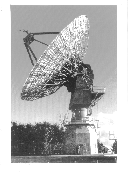 Green Bank 20-meter telescope.
Green Bank 20-meter telescope.
The 20-meter diameter telescope at the National
Radio Astronomy Observatory
(NRAO) in
Green Bank, WV,
was constructed by RSI and completed in late 1994.
It participated in geodetic VLBI experiments 1994 to 2000, described on this page.
Following its retirement in 2000 due to budget cutbacks at the USNO, it has been
used for testing focal-plane feed arrays and RFI cancellation by a group from
Brigham Young University, and most recently has been refurbished to become part
of the Radio Skynet system.
More up-to-date summary page:20-meter summary
Radio Skynet links:
UNC Radio Skynet project
20 m refurbishment project at Green Bank
Usage for Geodetic VLBI, 1994-2000 :
Run by NRAO and funded by the
US Naval Observatory (USNO),
it is part of the
National Earth Orientation Service
(NEOS)
telescope network, and part of the USNO geodetic network,
participating in a global program of Earth Orientation VLBI measurements
in cooperation with the
International Earth Rotation Service (IERS),
and with the
NASA Space Geodesy program.
The results of these measurements are published weekly in the
IERS Bulletin-A,
which lists the most recent polar motion and UT1 corrections and
predictions for three months in the future.
The experiments are designed to measure
small wobbling motions of the Earth's polar axis and irregularities
in the Earth's rate of rotation with reference to
positions of quasars (distant bright explosions in nuclei
of galaxies). Quasars are the most distant point-like radio sources
known, and therefore form a good set of stable reference points.
The resulting data are needed for high accuracy of world-wide
navigation systems. The data are also used for studies of
continental drift and of atmospheric and oceanic currents, in collaboration
with the
NASA Geodetic VLBI program.
Prior to the completion of the 20-meter, these geodetic VLBI experiments
have been using telescope 85-3, part of the
Green Bank Interferometer.
Other telescopes participating in the NEOS network are: Kokee Park
Geophysical Observatory (Kauai, Hawaii); Gilmore Creek Geophysical
Observatory (Fairbanks, Alaska); Wettzell, Germany; Fortaleza, Brazil;
and Algonquin Park (Ontario, Canada).
Telescope status:
The antenna was completed in November of 1994. The Green-Bank-built prime
focus receiver was installed on January 11, 1995. VLBI observing was done
in Jan-Feb to test and shake down the system.
In early March, the antenna encoders were borrowed
to fix a problem at the Kokee antenna (a twin of ours), so the Green Bank 20-meter was
inactive until replacement encoders were installed in October of 1995.
After further tests, regular operation was begun in November 1995.
Telescope specifications:
Type : Elevation over azimuth.
Reflector Diameter : 20 meters
F/D ratio : 0.43
Receiver : dual frequency/dual polarizations
Cooled (15K) HEMT at prime focus.
Frequency bands : 2.2 to 2.6 GHz; 8.2 to 9.0 GHz
Slew Speed : 2 degrees per second, each axis.
Surface Accuracy : 0.8 mm rms.
Geodetic Position : 38 26'12.661" N.Lat (ref: NAD1983 datum)
79 49'31.865" W.Long.
Approx. height of elev.axis: 842 m
Performance Data:
Calibrations in single-dish mode done in February find rms pointing
residuals of 34", and other performance data as follows:
X-band S-band
System Temps 46 K 31 K
SEFD 720 Jy 440 Jy
Aperture efficiency 55-59% 58-61%
Geocentric CIO position from VLBI data in Reference Frame Navy 1996-9.
X = 883772.7974 m +- 4.3 mm
Y = -4924385.5975 m +- 5.9 mm
z = 3944042.4991 m +- 5.2 mm
Field System documentation.
Return to Green Bank home page.
Go to main NRAO home page.
fghigo last changed this page
06 Oct 2000
 Green Bank 20-meter telescope.
Green Bank 20-meter telescope.  Green Bank 20-meter telescope.
Green Bank 20-meter telescope.